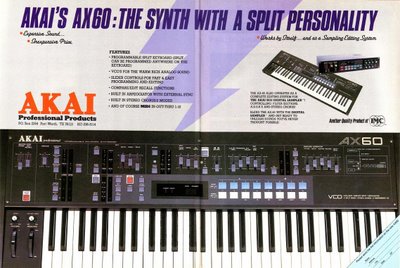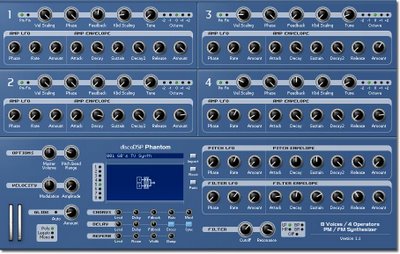
Title link takes you to shots pulled via
this auction.
Details:
"The Prophecy uses 7 different types of oscillators, giving it great flexibility in the kinds of sounds it can make. You can combine any 2 oscillators at a time, except for the physical models, which use all the available CPU power for 1 osc.
Standard Osc: Used for making classic analog style sounds. The waveshapes are Sawtooth, Pulse (square), and Ramp (triangle). Unlike almost all true analog synths, the Prophecy can do pulse-width modulation on all of these waveshapes, not just the Pulse wave. This allows you to add extra harmonics and change the tone color over time.
Comb Filter Osc: Mixes a saw, square, or triangle wave with white noise, and then runs it through a lowpass filter that has adjustable feedback. Great for making resonant, metallic, or whistling sounds.
VPM Osc: Variable Phase Modulation, which is almost identical to FM, or Frequency Modulation. One oscillator is used to modulate the pitch of a second osc. Then it goes through a waveshaper that adds harmonics, and there is an adjustable amount of feedback.
Modulation Osc: Used as a second osc after one of the other types listed above. It does ring modulation, cross modulation, or oscillator sync. These were the best ways to make hard-edged, metallic sounds on classic analog synths.
Brass Osc: Physical models of trumpets, trombones, and horns. Allows you to tweak the sound by setting the air pressure, breath noise, lip position and vibration, and the tone and resonance of the bell at the open end of the instrument.
Reed Osc: Physical models of saxophones, flutes, recorders, glass bottles, and whatnot. You can set air pressure, breath noise, and the resonance of the reed.
Pluck Osc: Physical models of plucked string sounds such as electric bass. You can adjust the attack, pluck noise, string position, vibration, inharmonicity, decay, and release.
Each oscillator goes through its own waveshaper, and there is adjustable feedback.
You can also add a suboscillator and white noise to further thicken the sound.
There are 2 resonant filters, which can be set to Lowpass, Highpass, Bandpass, and
Band Reject (notch).
The effects processor does Distortion, Wah, EQ, Delay, Reverb, Chorus/Flange and Pan.
All of these effects are always on, so you can use them all at once in a big chain.
A .PDF version of the manual is available
here."
 Via Amos.
Via Amos. Via Amos.
Via Amos. "# Original Roland knobs have been used, not the cheap plastic remolds supplied with the kit.
"# Original Roland knobs have been used, not the cheap plastic remolds supplied with the kit. This one via Erick. Title link takes you the rest. The current list includes Akai, Oberheim, Casio, Roland, E-MU, Sequential, Korg, Siel, and Yamaha.
This one via Erick. Title link takes you the rest. The current list includes Akai, Oberheim, Casio, Roland, E-MU, Sequential, Korg, Siel, and Yamaha.



 Title link takes you to shots pulled from this auction. There's a box in the set.
Title link takes you to shots pulled from this auction. There's a box in the set. Title link takes you to shots pulled via this auction.
Title link takes you to shots pulled via this auction. No title link. Just two shots via this auction.
No title link. Just two shots via this auction.












